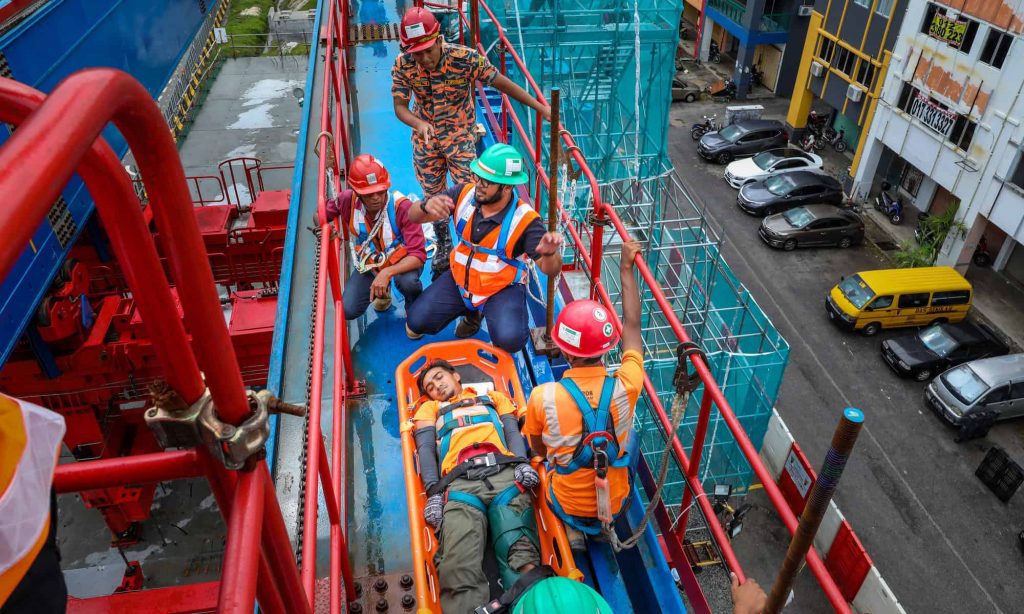Last month, MMC Gamuda KVMRT (PDP SSP) Sdn Bhd (MMC Gamuda) and Work Package Contractor (WPC) MTD Construction Sdn Bhd conducted their mandatory emergency response drill at the Taman Pinggiran Putra construction site.
The drill simulated an accident on top of the Launching Gantry (LG) for the elevated portion of the line. There to oversee the drill was MMC Gamuda Launching Specialist Mark Adams.
Read More: Emergency response drill at MRT SSP Line elevated worksite
Part of Mark’s role is to review the LG processes and its documentation for each work package of the MRT SSP Line and to conduct workshops with the LG engineers and foremen.
We sat down with Mark to gain an insight on the benefits of emergency response drills when working with LG equipment.
Q: Explain what happened and why the drill is important?
Mark Adams (MA): The drill is about understanding how the Fire and Rescue Department of Malaysia (Bomba) evacuates the victim from a Launching Gantry in the case of an emergency, including what they need to do, what their requirements are and how we can better facilitate this process in the future.
It is an important exercise to establish communication lines between Bomba, PDP Project Manager, WPC Site Manager and also the Emergency Response Team (ERT).
It is also especially good for MMC Gamuda as PDP to observe the Safety, Health and Environment (SHE) behaviours of our WPCs during such incident and what they can learn from this experience.
Q: What did the team learn from the drill?
MA: There are many different types of LG at our worksites and so many different places where an accident can happen.
Each accident can be different, and each scenario is a new experience. Therefore, the purpose of the drill is about establishing a learning procedure that can be easily replicated for each LG.
For example, by Bomba coming in and taking over the rescue operation, the team is able to learn how Bomba evacuates an injured person from the LG. The team also saw that the most challenging part of the rescue was manoeuvring of the stretcher over the LG handrail.
Learning from here is for a more systematic and proper response plan and modifying the handrail to allow the rescue team to access the victim faster.
Q: What is the importance of this working relationship with Bomba?
MA: The main objective of this teamwork is to establish the timeframe from the moment Bomba is called until the injured person is rescued and brought to the ground. For this drill, we have engaged with Bomba so that they can show us how to do it professionally.
Moving forward, the ERT will have to develop their own rescue work procedures and response plan which should take not more than 20 minutes.
To get there though, we have to practise various scenarios such as fire, structure collapse, bomb threat, flooding and landslide to name a few on a more regular basis so that everyone is familiar with the emergency response procedure.
Eventually, we want to get to a position where the ERT can provide immediate response to the emergency and if possible contain the situation until the arrival of external emergency services or assistance. We also want the team to reach a level where they can assist external emergency services by providing them appropriate information on the condition of the emergency as well as the operations and procedure carried out by the ERT.
Q: What other training can be done internally to improve this process?
MA: We have a total of 26 LGs on the MRT SSP Line project and each site crew is required to perform this drill adequately. Our goal is to take the emotions out of an emergency situation so that each team has high level of preparedness and knows what to do.
We try as much as possible to collaborate and carry out emergency drill exercise with the presence of Bomba once every six months but I believe it is also up to each crew to do their own internal practices on a regular basis — get the stretcher out, get everyone familiar with the stretcher, get a real body in the stretcher and teach them how to strap the person in and pick them up.
Through frequent own internal training, we are confident we can increase the awareness of the SHE behaviours within our project team, contractors, workers as well as the public when dealing with Launching Gantries on the MRT SSP Line.
Find out more about MMC Gamuda’s approach to SHE initiatives here.

